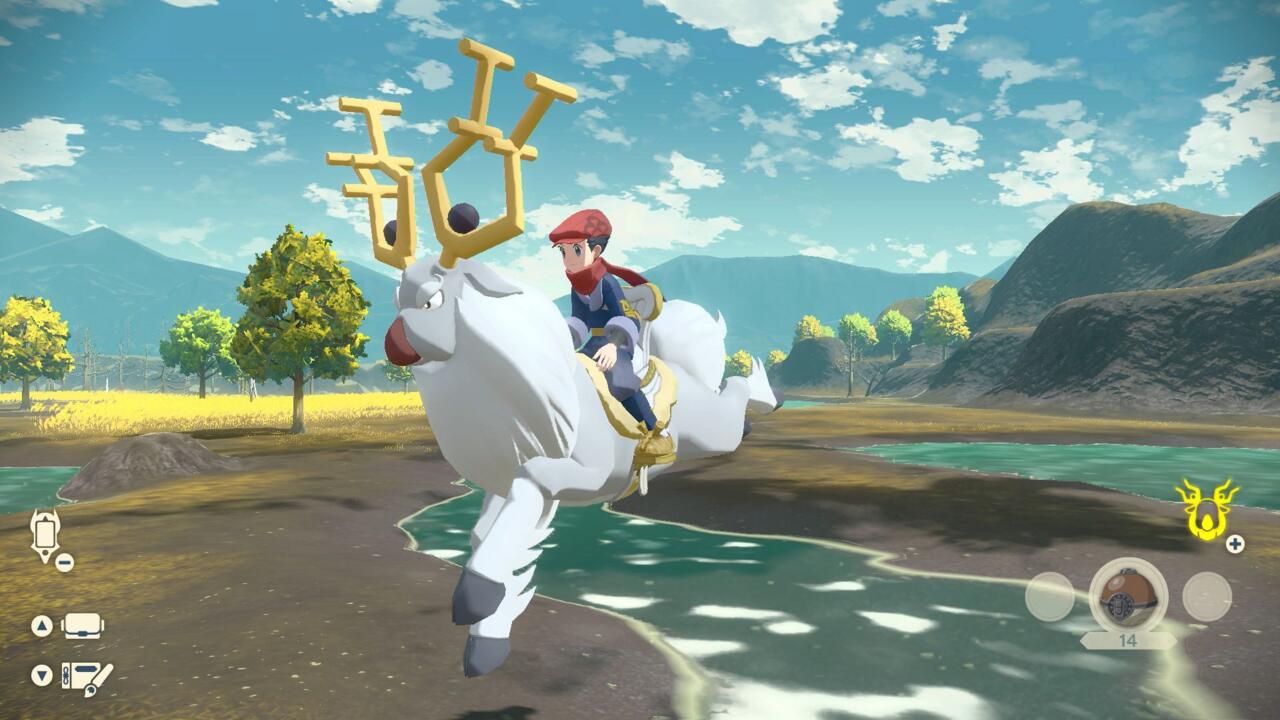In 1996, Pokemon was daring. The oddball RPG was both mechanically simpler and more ambitious than its contemporaries, consisting of an approachable battle system and a huge roster of 150 adorable mascot characters. Since then, the core Pokemon games have mostly stuck to the pattern established by those first games, developing a sense of familiarity with steady, light iteration. Pokemon Legends: Arceus breaks that iterative pattern, attempting to establish a new foundation while borrowing bits and pieces from the main Pokemon games to create something new. The result is sometimes messy and doesn’t always work, but its distinct qualities set it apart from the core series and ultimately elevate it.
Though it’s a spin-off, Pokemon Legends: Arceus isn’t lending the Pokemon trappings to an entirely different set of mechanics like the Mystery Dungeon or Stadium series. Instead, this game reimagines Pokemon’s core mechanics–finding and catching Pokemon and battling with them–within the new context of exploring vast 3D open spaces.00:02 / 08:00
- Auto
- HD
- High
- Low
Report a problem
Now Playing: Pokémon Legends: Arceus Video Review
Legends: Arceus takes place long before the modern games, at a time when Pokemon haven’t become integrated into daily life as pets and pack animals. There is a sense that the wilderness here is dangerous and the villagers treat Pokemon like fearsome, wild beasts. The exception to this is the Survey Corps, a small band of burgeoning scientists working underneath the local security forces. When you drop into the world, the Survey Corps almost immediately recognizes your knack for its style of research and puts you to work.
An ever-present rift in the sky appears to be driving Pokemon berserk, including larger-than-life sacred Pokemon that are given special reverence and protection by the local Diamond and Pearl tribes. As a stranger in a strange land with no other options, you join up with the Survey Corps in hopes of solving the mystery of the rift.
The Survey Corps’ day-to-day work is building the first Pokedex, a paperbound notebook that compiles all of the region’s accumulated Pokemon knowledge. The Corps even has some basic knowledge of how to catch Pokemon, including how to build a rudimentary PokeBall out of found materials. Completing your Pokedex is always the goal of Pokemon games, but it’s usually an incidental secondary goal to collecting new Pokemon in order to train them for battles. In Arceus, completing the Pokedex is front-and-center, reintroducing it as a pivotal goal that connects everything you do, including how you progress through the game.
Though the process of completing the Pokedex involves similar mechanics to what’s found in the mainline Pokemon games, Legends: Arceus makes it a bit more involved. You can see the Pokemon wandering free around the open environments, as in Sword and Shield’s Wild area. But you don’t necessarily need to do battle to engage them. You can quietly sneak up on them, approaching slowly while their back is turned or hiding in some tall grass, and toss a PokeBall at them. That’s often enough to catch them, so you go through PokeBalls quickly–dozens in a single trip–building out your collection. You can also bait them using their favorite foods to distract them as you’re creeping up behind them. If they do notice you, they might attack you–if need be, you can dodge-roll out of the way or just run from the area, but the only real defensive tools you have are the Pokemon you’ve already caught. In a pinch, you can toss them into the fray to initiate a battle.
Altogether this central gameplay loop takes the ideas that were previously left to the imagination and obscured behind RPG mechanics in the mainline Pokemon games, and recontextualizes them to be more active and personal. It’s possible that all those times you got into a random encounter in previous Pokemon games, the monster first targeted you, and you tossed out a PokeBall to protect yourself in battle, and the battle system approximated that idea by presenting it as a random encounter. But here, it’s very literal. You’re at risk of getting hurt by a wild creature and your little pocket monsters are the only reliable answer at your disposal. It’s satisfying to finally actually feel the tension of a wild beast attacking you, and to unleash your own trained monster to protect you.
The controls behind this binary approach–stealth vs. an outright attack, capturing vs. initiating a Pokemon battle–can be disorienting. The trigger button is used to toss whatever you have at the ready, and you toggle between a menu of PokeBalls and other objects like bait and a separate menu of caught Pokemon using the X button. It’s fairly intuitive most of the time, cycling through your arsenal and then aiming a shot, but in the heat of the moment it’s easy to waste a PokeBall when you meant to start a battle–or worse, to start a battle when you were trying to be sneaky.
In a mainline Pokemon game, simply catching a Pokemon would fill out its Pokedex entry but that’s not the case here. Since you’re building the first Pokedex, and since the stealth-catch mechanic lends itself to quicker finds, completing a Pokedex entry involves completing a series of tasks. A Pokedex sheet will outline tasks–often with multiple tiers–like catching a certain number of a Pokemon, defeating a certain number, catching a number without being noticed, seeing it use a certain move, feeding them a number of times, and so on. Once you’ve completed a number of these tasks, you can turn in your findings and the Pokedex entry is considered complete.
It’s a remarkably flexible system that lets you play Pokemon your own way. If you love to do Pokemon battles, you can make almost all of your progress just fighting wild monsters. (I’ll be exploring battles in more detail shortly). If you’d rather focus on stealth and barely engage with battles at all, that option is available too. At first, I found myself obsessively checking my Pokedex tasks and steering myself toward min-maxing completion, flipping through Pokedex pages looking for the ones I needed. But after a while, I found it was much more enjoyable to just wander the world stealth-catching and battling as I felt like it, and then letting the chips fall where they may for Pokedex completion.
This also leads to a much different sense of party dynamics than a typical Pokemon game. Since you’re catching Pokemon by the barrel-full and evolving Pokemon isn’t necessarily needed to complete their Pokedex entries, there’s less incentive to keep a core team of favorites on-hand and passively level them up throughout the game. I was hot-swapping my team in the field constantly by checking in at base camps, substituting any Pokemon that had been outclassed by a newer catch. But that means some of my old favorites, including my starter, have been sitting in cold storage for hours. I found myself missing that feeling of forming a special bond with my starter Rowlet and keeping him with me throughout the game.
Sating these beasts is the most exciting the series has been in years.
Unfortunately, campaign progress gating is also tied to completing Pokedex survey results. The Survey Corps awards star rankings that level up as you gain research points for completing tasks and filling out Pokedex entries. New environments open up as you progress through the story, but between each major story point, you need to rank up to the next star level. That meant that for the first few star ranks, I was stuck needing to go over areas I had already explored extensively, grinding to progress enough to proceed. Later in the game, once I gained access to a larger selection of environments–and had access to mounts that made new areas reachable–it was much easier to progress without feeling like I had to go back over a previous area with a fine-toothed comb.
The battle system is possibly the most recognizable aspect from previous Pokemon games, with each Pokemon in Legends: Arceus only being able to equip a total of four moves at a time and all the usual rock-paper-scissors elemental match-ups intact. But needing to know the finer nuances to type matchups is deemphasized in Arceus, to the point where moves are just listed as Effective, Super Effective, Not Very Effective, and No Effect from the start. More recent Pokemon games have included this feature, and I appreciate the help as someone who does not have the brain-space to keep track of every move match-up, but it has previously kept those hints gated behind having completed a Pokedex entry. In Pokemon Legends: Arceus that rough edge is sanded down to be even smoother, since you’ll see them listed right away, even the first time you ever encounter a new Pokemon.
You can also get into an encounter against multiple Pokemon, sometimes just through sheer luck by starting a battle in the middle of a crowd of wild creatures. These moments can feel appropriately harrowing, since you can still only have one monster out at a time. And sometimes you’ll simply run into Pokemon far above your level, including red-eyed “Alpha” Pokemon that are larger and more powerful than the average for their species. If you can catch them, they’re essentially the apex predators of their type with the requisite stat bump.
Adding a small but sometimes-vital wrinkle to the battle system is the option to make any of your attacks “Agile” or “Strong” style. An Agile attack sacrifices some strength for speed, which sometimes lets you attack twice before your opponent can respond. Conversely, a Strong attack will pack some extra punch, but it might slow you down enough that your opponent can act twice. An optional battle timeline shows when turns will occur, so you can see how swapping between Agile and Strong moves will affect the turn order. This adds an extra layer of creativity and strategy, especially once you start supplementing less effective attacks with Strong style because you want to inflict a status effect, or using Agile style on a Super Effective attack to finish an opponent off quickly. Your opponents can make their attacks Agile or Strong too, so it cuts both ways, increasing the number of variables you have to consider in the midst of a fight and making it that much more fulfilling when your strategy pays off with a victory.
A series of boss battles called Frenzy battles are also a significant change from the Pokemon norm. These large-scale conflicts tie into the story, as you work with each Pokemon’s caretaker “Warden” to learn what kinds of foods they like so you can make special Balms. You then go into a distinct arena where you have to dodge the rampaging Pokemon’s attacks and hit it with Balms, only occasionally sending out your own Pokemon to stun it long enough that you can rapid-fire Balms at it. Sating these beasts by juggling the priorities of active dodging, looking for open opportunities to throw, and then mixing in traditional Pokemon battles is the most exciting the series has been in years.
The Wardens and the leaders of their clans are standout personalities in Legends: Arceus, introducing a totally new cast of characters but keeping the focus relatively small. Pokemon games often have a fairly sprawling cast of friends, professors, gym leaders, Elite Four members, and the Champion, and we rarely get to know any of them particularly well. In Legends: Arceus, there are less than a dozen main characters, and we spend much more time with them, getting to know their personalities and how they clash with each other. There’s not a massive amount of depth to the story and characters, but I still got attached to these cute anime kids.

